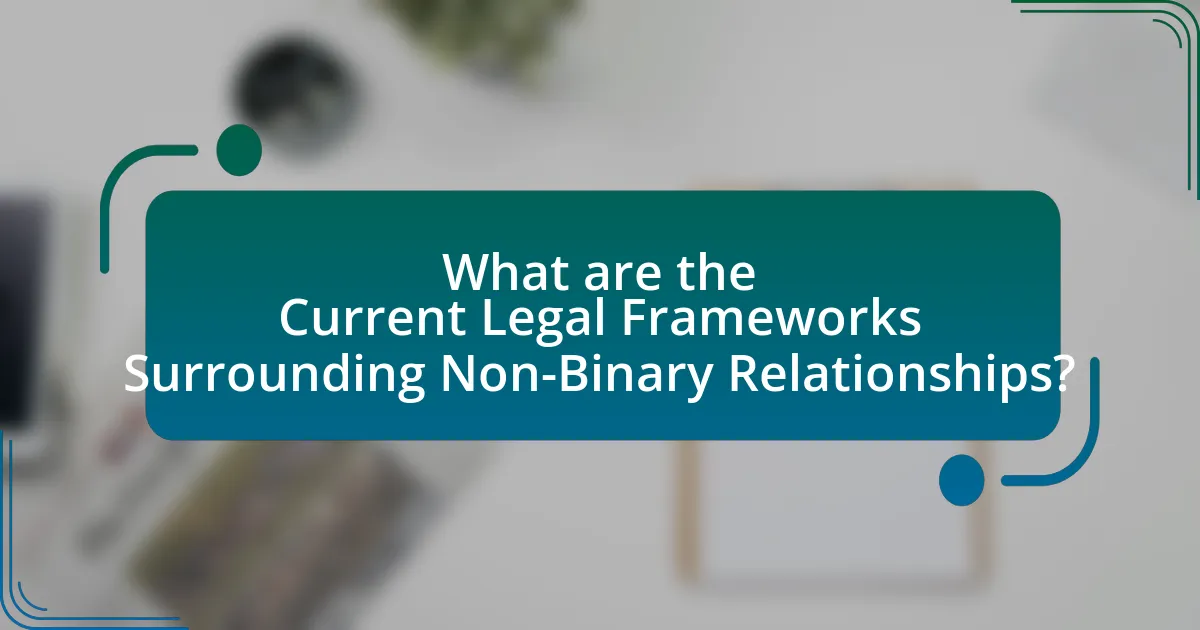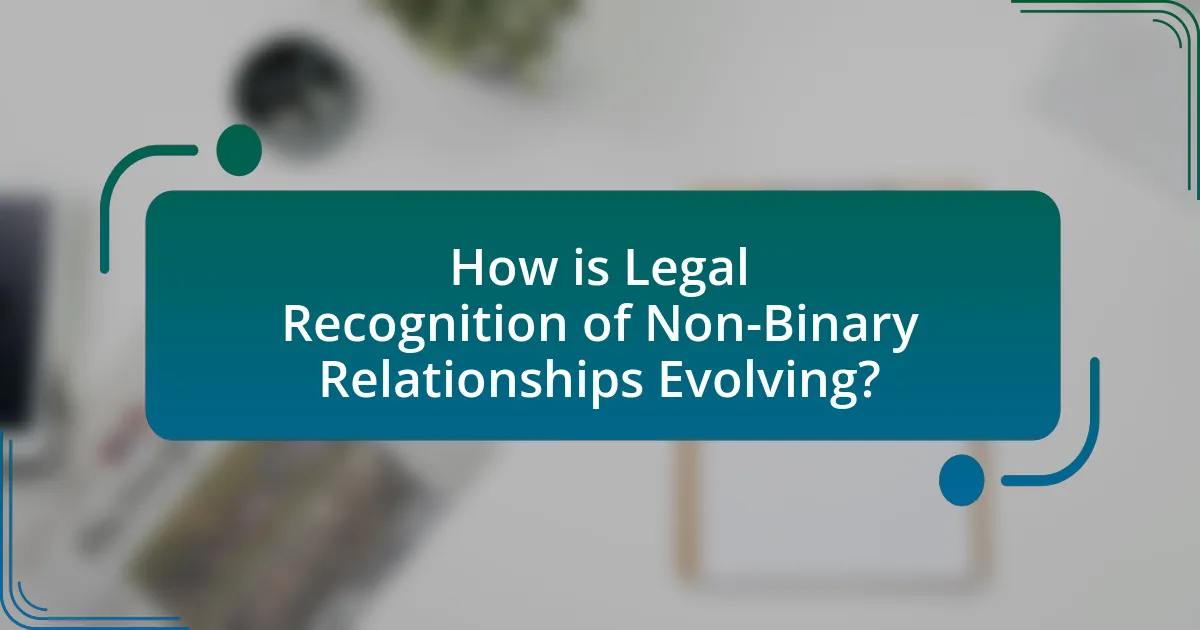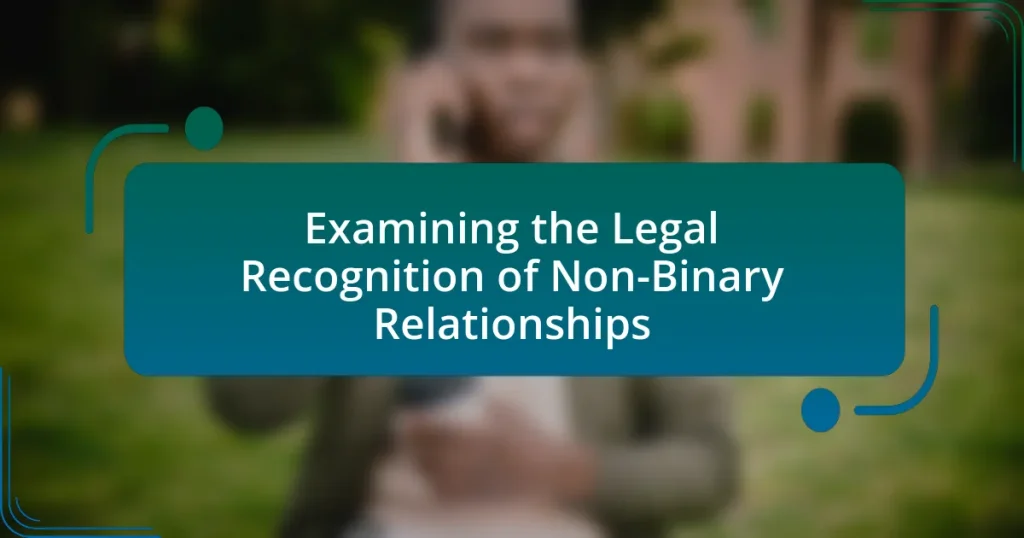The article examines the legal recognition of non-binary relationships, highlighting the significant variations in legal frameworks across different jurisdictions. It discusses how non-binary relationships differ from traditional relationships, the essential definitions needed to understand these dynamics, and the cultural perceptions that influence legal recognition. The importance of legal recognition for non-binary individuals is emphasized, detailing the rights and protections it affords, as well as the impact on social acceptance. Additionally, the article outlines current legal frameworks, challenges faced in achieving recognition, and the evolving landscape of legal acknowledgment for non-binary relationships, including recent legislative changes and the role of advocacy groups.

What is the Legal Recognition of Non-Binary Relationships?
Legal recognition of non-binary relationships varies significantly across jurisdictions. In some regions, non-binary individuals can legally marry or enter into civil partnerships, while others may not recognize non-binary identities at all. For instance, countries like Canada and Australia have made strides in recognizing non-binary gender identities in legal documents, allowing for inclusive marriage laws. Conversely, many states in the United States still do not have specific provisions for non-binary relationships, leading to legal ambiguities. This inconsistency highlights the ongoing need for legal reforms to ensure equitable recognition of non-binary relationships globally.
How do non-binary relationships differ from traditional relationships?
Non-binary relationships differ from traditional relationships primarily in their recognition of gender identities beyond the male-female binary. Traditional relationships typically operate within a framework that assumes two genders, often leading to legal and social structures that reinforce this binary. In contrast, non-binary relationships acknowledge and validate a spectrum of gender identities, which can influence aspects such as legal recognition, rights, and societal acceptance. For instance, some jurisdictions have begun to recognize non-binary identities in legal documents, allowing individuals to identify as “X” or “non-binary” on official forms, which is a significant departure from the traditional male or female classifications. This shift reflects a broader understanding of gender and its implications for relationship dynamics, rights, and societal norms.
What definitions are essential for understanding non-binary relationships?
Essential definitions for understanding non-binary relationships include “non-binary,” which refers to gender identities that do not fit within the traditional binary of male and female, and “gender identity,” which is an individual’s personal sense of their gender, which may or may not correspond with the sex assigned at birth. Additionally, “gender expression” is crucial, as it encompasses the external presentation of gender through behavior, clothing, and other forms of expression. Understanding these terms is vital for recognizing the complexities of non-binary relationships, as they highlight the diverse ways individuals experience and express their gender. The increasing visibility of non-binary identities has led to legal discussions regarding recognition and rights, emphasizing the importance of these definitions in the context of legal frameworks.
How do cultural perceptions influence the recognition of non-binary relationships?
Cultural perceptions significantly influence the recognition of non-binary relationships by shaping societal norms and legal frameworks. In cultures where binary gender norms are predominant, non-binary identities often face marginalization, leading to limited legal recognition and social acceptance. For instance, countries like Canada and Australia have made strides in recognizing non-binary identities through legal reforms, reflecting a shift in cultural attitudes towards gender diversity. Conversely, in regions with rigid gender roles, non-binary relationships may lack legal acknowledgment, impacting individuals’ rights and access to services. This disparity illustrates how cultural beliefs directly affect the visibility and legitimacy of non-binary relationships within legal systems.
Why is legal recognition important for non-binary relationships?
Legal recognition is important for non-binary relationships because it provides essential rights and protections that validate the identities and experiences of non-binary individuals. Without legal recognition, non-binary relationships may face challenges in areas such as healthcare, inheritance, and parental rights, which can lead to discrimination and marginalization. For example, a study by the Williams Institute found that legal recognition significantly improves mental health outcomes for LGBTQ+ individuals, including non-binary people, by reducing stigma and increasing social acceptance. Thus, legal recognition not only affirms the legitimacy of non-binary relationships but also enhances the overall well-being of those involved.
What rights and protections are afforded through legal recognition?
Legal recognition affords individuals in non-binary relationships rights and protections such as access to legal benefits, inheritance rights, and healthcare decision-making authority. These rights ensure that non-binary individuals can make medical decisions for their partners, inherit property without legal complications, and access spousal benefits like health insurance. For instance, in jurisdictions that recognize non-binary relationships, individuals may be entitled to the same legal protections as heterosexual and same-sex couples, including rights related to taxation, social security, and family leave. This legal framework is supported by various laws and court rulings that affirm the rights of non-binary individuals, thereby enhancing their social and legal standing.
How does legal recognition impact social acceptance of non-binary relationships?
Legal recognition significantly enhances social acceptance of non-binary relationships by providing legitimacy and visibility to these partnerships. When non-binary relationships are legally recognized, it affirms the identities of individuals involved, fostering a broader societal understanding and acceptance. Research indicates that legal recognition leads to increased public awareness and reduces stigma, as seen in countries that have implemented inclusive laws. For example, studies show that after the legalization of same-sex marriage in various regions, there was a marked increase in acceptance of diverse gender identities and relationships, illustrating the positive correlation between legal status and social attitudes.

What are the Current Legal Frameworks Surrounding Non-Binary Relationships?
Current legal frameworks surrounding non-binary relationships vary significantly across jurisdictions, with some regions recognizing non-binary identities in legal documents while others do not. For instance, countries like Canada and Australia have made strides in recognizing non-binary gender identities, allowing individuals to select a non-binary option on official documents such as passports and driver’s licenses. In the United States, some states have adopted similar measures, enabling non-binary individuals to identify as such on legal forms, but there is no federal recognition. Legal frameworks often intersect with issues of marriage, custody, and anti-discrimination laws, which can further complicate the legal standing of non-binary relationships. The lack of uniformity in legal recognition highlights ongoing challenges faced by non-binary individuals in asserting their rights and identities within the legal system.
Which countries have recognized non-binary relationships legally?
Countries that have legally recognized non-binary relationships include Canada, Germany, and Australia. In Canada, non-binary gender options are available on government documents, and some provinces recognize non-binary relationships legally. Germany allows for a third gender option on birth certificates, which supports non-binary recognition. Australia has also made strides by allowing non-binary gender markers on passports and recognizing non-binary relationships in certain jurisdictions. These legal frameworks demonstrate a growing acknowledgment of non-binary identities in these countries.
What legal statuses are available for non-binary relationships in these countries?
Legal statuses for non-binary relationships vary significantly across countries. In some nations, non-binary individuals can register their relationships under existing frameworks such as civil partnerships or domestic partnerships, which may not explicitly recognize non-binary identities but allow for legal recognition of relationships. For instance, countries like Canada and Germany have made strides in recognizing non-binary identities within their legal systems, allowing for gender-neutral options on legal documents. However, many countries still lack specific legal recognition for non-binary relationships, leaving individuals without formal acknowledgment of their partnerships. This inconsistency highlights the ongoing need for legal reforms to ensure equitable recognition for non-binary individuals globally.
How do these legal frameworks vary across different jurisdictions?
Legal frameworks regarding non-binary relationships vary significantly across jurisdictions, reflecting differing cultural, social, and legal attitudes toward gender identity. For instance, countries like Canada and Germany legally recognize non-binary gender identities, allowing individuals to select a gender-neutral option on official documents, while many U.S. states have varying degrees of recognition, with some allowing non-binary markers on driver’s licenses and others not recognizing non-binary identities at all. In contrast, jurisdictions such as Saudi Arabia and Iran do not recognize non-binary identities, enforcing strict binary gender classifications based on traditional interpretations of gender roles. This disparity illustrates how legal recognition of non-binary relationships is influenced by local laws, societal norms, and historical contexts.
What challenges exist in achieving legal recognition for non-binary relationships?
Achieving legal recognition for non-binary relationships faces significant challenges, primarily due to existing legal frameworks that predominantly recognize only binary gender identities. Many jurisdictions lack specific laws that acknowledge non-binary identities, leading to legal ambiguities in areas such as marriage, parental rights, and inheritance. For instance, in the United States, the absence of a federal standard for non-binary gender recognition means that individuals may encounter varying degrees of acceptance and legal protection depending on the state. Additionally, societal norms and biases can influence lawmakers, resulting in resistance to change and the perpetuation of traditional definitions of relationships. These factors collectively hinder the progress toward equitable legal recognition for non-binary relationships.
What legal barriers do non-binary individuals face in different regions?
Non-binary individuals face various legal barriers across different regions, primarily related to the lack of legal recognition of their gender identity. In many countries, legal systems only recognize binary gender categories, which complicates non-binary individuals’ ability to obtain identification documents that reflect their gender. For instance, in the United States, only a limited number of states allow for a non-binary option on driver’s licenses and identification cards, creating inconsistencies and potential discrimination. Similarly, in countries like Japan and South Korea, legal recognition of non-binary identities is virtually non-existent, forcing individuals to navigate legal systems that do not acknowledge their existence. Furthermore, in regions where gender identity is not legally recognized, non-binary individuals may face challenges in areas such as healthcare access, employment rights, and protection against discrimination, as laws often do not provide adequate safeguards for non-binary identities.
How do societal attitudes affect the legal recognition process?
Societal attitudes significantly influence the legal recognition process by shaping public opinion and legislative priorities. When a society holds progressive views towards non-binary relationships, lawmakers are more likely to introduce and support legislation that recognizes these relationships legally. For instance, countries like Canada and Germany have enacted laws acknowledging non-binary gender identities, reflecting a societal shift towards inclusivity. Conversely, in societies where traditional gender norms prevail, legal recognition for non-binary relationships is often limited or non-existent, as seen in many regions where legal frameworks do not accommodate diverse gender identities. This correlation between societal attitudes and legal recognition underscores the importance of public perception in driving legislative change.

How is Legal Recognition of Non-Binary Relationships Evolving?
Legal recognition of non-binary relationships is evolving through legislative changes and court rulings that increasingly acknowledge diverse gender identities. For instance, countries like Canada and Australia have implemented legal frameworks that allow for non-binary gender markers on official documents, which supports the recognition of non-binary relationships. Additionally, various jurisdictions are beginning to recognize non-binary partnerships in family law, allowing for equitable treatment in matters such as marriage, adoption, and inheritance. This shift is evidenced by the growing number of legal cases and advocacy efforts aimed at ensuring that non-binary individuals receive the same rights and protections as their binary counterparts, reflecting a broader societal acceptance of gender diversity.
What recent legal changes have occurred regarding non-binary relationships?
Recent legal changes regarding non-binary relationships include the recognition of non-binary gender identities in various jurisdictions, allowing individuals to identify as non-binary on legal documents such as driver’s licenses and passports. For instance, in 2021, the state of California enacted legislation permitting a non-binary gender option on state-issued identification, reflecting a growing trend towards legal acknowledgment of non-binary identities. Additionally, countries like Canada and Australia have also implemented similar measures, enhancing legal protections and recognition for non-binary individuals in relationships. These changes signify a broader movement towards inclusivity and equality in legal frameworks.
How have court rulings influenced the recognition of non-binary relationships?
Court rulings have significantly influenced the recognition of non-binary relationships by establishing legal precedents that affirm the validity of non-binary identities. For instance, in 2019, the U.S. District Court for the District of Columbia ruled in favor of a non-binary individual seeking to change their gender marker on legal documents, which set a precedent for recognizing non-binary identities in legal contexts. This ruling, along with others in various jurisdictions, has led to increased visibility and acceptance of non-binary relationships in family law, inheritance rights, and anti-discrimination protections. Additionally, countries like Canada have implemented legal frameworks that explicitly recognize non-binary gender identities, further solidifying the legal standing of non-binary relationships. These court decisions collectively contribute to a broader societal acknowledgment of non-binary individuals and their relationships, promoting equality under the law.
What role do advocacy groups play in promoting legal recognition?
Advocacy groups play a crucial role in promoting legal recognition by raising awareness, influencing policy, and mobilizing public support for non-binary relationships. These organizations often conduct research, provide legal resources, and engage in lobbying efforts to push for legislative changes that acknowledge and protect the rights of non-binary individuals. For instance, the Human Rights Campaign has been instrumental in advocating for inclusive policies, demonstrating that organized efforts can lead to significant legal advancements, such as the introduction of gender-neutral options on identification documents in various jurisdictions.
What future trends can be anticipated in the legal recognition of non-binary relationships?
Future trends in the legal recognition of non-binary relationships include increased legislative reforms aimed at acknowledging diverse gender identities and relationship structures. Countries such as Canada and Germany have already begun implementing legal frameworks that recognize non-binary individuals, which sets a precedent for other nations to follow. Additionally, advocacy from LGBTQ+ organizations is likely to drive further changes, as public awareness and acceptance of non-binary identities continue to grow. This trend is supported by data indicating that younger generations are more inclusive of diverse gender identities, suggesting a societal shift that may influence policymakers.
How might upcoming legislation impact non-binary relationships?
Upcoming legislation may enhance the legal recognition and rights of non-binary relationships by providing clearer definitions and protections under the law. For instance, laws that recognize non-binary gender identities can lead to inclusive marriage and partnership rights, allowing non-binary individuals to access the same legal benefits as binary counterparts. In jurisdictions where such legislation has been enacted, there has been a notable increase in the acknowledgment of diverse family structures, which supports the validity of non-binary relationships in legal contexts.
What societal shifts could influence future legal recognition efforts?
Societal shifts such as increased visibility and acceptance of LGBTQ+ identities, particularly non-binary individuals, could significantly influence future legal recognition efforts. As public awareness grows through media representation and advocacy, societal attitudes are shifting towards greater inclusivity, which can lead to legislative changes. For instance, countries like Canada and Germany have already implemented legal recognition for non-binary genders, reflecting a broader trend towards acknowledging diverse gender identities. Additionally, the rise of social movements advocating for equality and human rights has pressured governments to reconsider outdated legal frameworks, further supporting the push for legal recognition of non-binary relationships.
What practical steps can individuals take to advocate for legal recognition of non-binary relationships?
Individuals can advocate for legal recognition of non-binary relationships by engaging in grassroots activism, lobbying for legislative changes, and raising public awareness. Grassroots activism involves organizing or participating in local events, such as pride parades or community forums, to highlight the importance of non-binary recognition. Lobbying for legislative changes can include contacting local representatives, drafting petitions, and supporting bills that aim to amend existing laws to include non-binary relationships. Raising public awareness can be achieved through social media campaigns, educational workshops, and collaborations with LGBTQ+ organizations to inform the public about the significance of legal recognition for non-binary individuals. These steps are supported by the increasing visibility of non-binary identities in society, as evidenced by the growing number of jurisdictions that have begun to recognize non-binary gender options in legal documents.
How can individuals engage with local advocacy groups effectively?
Individuals can engage with local advocacy groups effectively by participating in meetings, volunteering for events, and contributing to discussions. Active participation allows individuals to understand the group’s goals and strategies, fostering a sense of community and shared purpose. Volunteering for events, such as awareness campaigns or fundraisers, provides practical support and enhances visibility for the cause. Contributing to discussions, whether in person or through online platforms, helps shape the advocacy group’s direction and ensures diverse perspectives are considered. Research indicates that grassroots involvement significantly increases the impact of advocacy efforts, as seen in successful campaigns for legal recognition of non-binary relationships in various jurisdictions.
What resources are available for educating others about non-binary relationships?
Resources available for educating others about non-binary relationships include books, online courses, and community organizations. Notable books such as “Nonbinary: Memoirs of Gender and Identity” edited by Micah Rajunov and Scott Duane provide personal narratives that enhance understanding. Online platforms like Coursera and Udemy offer courses focused on gender diversity, including non-binary identities. Additionally, organizations such as the Human Rights Campaign and Gender Spectrum provide educational materials and workshops aimed at fostering awareness and acceptance of non-binary relationships. These resources collectively contribute to a more informed perspective on non-binary identities and their legal recognition.


